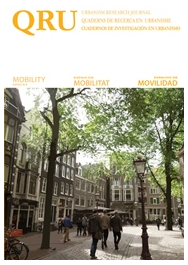Conectar e integrar fragmentos: la contribución de las Rondas de Barcelona
DOI:
https://doi.org/10.5821/qru.9599Resum
Pasados alrededor de 25 años del proyecto y ejecución de las Rondas de Dalt y del Litoral en Barcelona, se identifican cambios en los escenarios del proyecto y fenómenos posteriores, recurrentes a otras vías de circunvalación, como la disminución de las mejorías iniciales ofrecidas a la movilidad. Sin embargo, el proyecto sigue siendo sugerente por su propuesta de articulación de los desplazamientos de paso a través (característicos de los anillos de circunvalación) y los desplazamientos locales de irrigación de los barrios periféricos. A partir de una sección cambiante, flexible a los datos del territorio de implantación, su diseño redujo los efectos de corte habituales en estas infraestructuras y logró coser, vertebrar y formalizar los fragmentos que por entonces componían la periferia de la ciudad. Frente a nuevos escenarios de la ciudad metropolitana y a los desafíos de la movilidad actual, el proyecto merece ser revisado pues aporta nociones conceptuales de peso a las soluciones posibles.Descàrregues
Número
Secció
Llicència
Aquellos autores/as que tengan publicaciones con esta revista, aceptan los términos siguientes:
Los autores/as conservarán sus derechos de autor y garantizarán a la revista el derecho de primera publicación de su obra, el cuál estará simultáneamente sujeto a la Licencia de reconocimiento de Creative Commons CC BY-NC-ND- 4.0 que permite a terceros compartir la obra siempre que se indique su autor y su primera publicación esta revista, pero no se pueden cambiar ni se pueden utilizar comercialmente.
Los autores/as podrán adoptar otros acuerdos de licencia no exclusiva de distribución de la versión de la obra publicada (p. ej.: depositarla en un archivo telemático institucional o publicarla en un volumen monográfico) siempre que se indique la publicación inicial en esta revista.
Se permite y recomienda a los autores/as difundir su obra a través de Internet (p. ej.: en archivos telemáticos institucionales o en su página web) antes y durante el proceso de envío, lo cual puede producir intercambios interesantes y aumentar las citas de la obra publicada. (Véase El efecto del acceso abierto).













